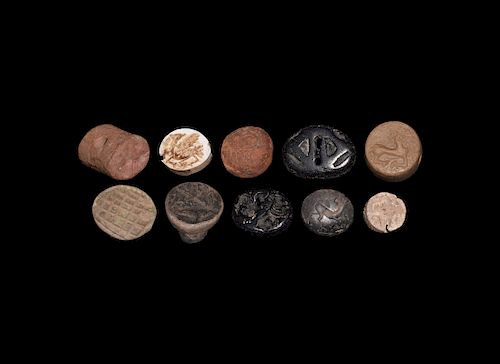Western Asiatic Stamp Seal Collection
Lot 418
About Seller
TimeLine Auctions Limited
The Court House, 363 Main Road
Harwick, Essex CO12 4DN
United Kingdom
Estimate:
GBP£800 - GBP£1,000
$1,000 - $1,250
Absentee vs Live bid
Two ways to bid:
- Leave a max absentee bid and the platform will bid on your behalf up to your maximum bid during the live auction.
- Bid live during the auction and your bids will be submitted real-time to the auctioneer.
Bid Increments
| Price | Bid Increment |
|---|---|
| GBP£0 | GBP£5 |
| GBP£100 | GBP£10 |
| GBP£200 | GBP£20 |
| GBP£500 | GBP£50 |
| GBP£1,000 | GBP£100 |
| GBP£2,000 | GBP£200 |
| GBP£5,000 | GBP£500 |
| GBP£10,000 | GBP£1,000 |
| GBP£20,000 | GBP£2,000 |
| GBP£50,000 | GBP£5,000 |
| GBP£100,000 | GBP£10,000 |
| GBP£250,000 | GBP£20,000 |
About Auction
By TimeLine Auctions Limited
Nov 23, 2018
Set Reminder
2018-11-23 05:00:00
2018-11-23 05:00:00
America/New_York
Bidsquare
Bidsquare : TimeLine Auctions London Mayfair Sale
https://www.bidsquare.com/auctions/timeline-auctions-limited/timeline-auctions-london-mayfair-sale-3572
Auction Venue: The May Fair Hotel London Stratton Street Mayfair London, W1J 8LT Viewing from noon Thursday 22nd Nov. 2018 Champagne Reception: 6pm - 9pm Friday 23rd Nov. 2018 (Day 1) 10am : Lots 1 - 660 TimeLine Auctions Limited enquiries@timelineauctions.com
Auction Venue: The May Fair Hotel London Stratton Street Mayfair London, W1J 8LT Viewing from noon Thursday 22nd Nov. 2018 Champagne Reception: 6pm - 9pm Friday 23rd Nov. 2018 (Day 1) 10am : Lots 1 - 660 TimeLine Auctions Limited enquiries@timelineauctions.com
- Lot Description
2nd-1st millennium BC. A mixed group of stone stamp seals, mainly drum-shaped or plano-convex in profile, including four accompanied by an old scholarly note, typed and signed by W.G. Lambert, late Professor of Assyriology, University of Birmingham, 1970-1993, which state: (V-646) 'Bifacial Stamp Seal of White Stone 12 x 12 x 6 mm. This is a thick round disc, with hatched band round the sides, through which it is pierced. The designs on both sides depend mostly on hatched cuts. the one side has a simple cross and fillers in the four areas remaining. The other side has a central motif and four v-shapes around it. This comes from west central Asia and daters to c. 2000 B.C. It is a little damaged, but is generally in fair condition.' (T-320) 'Bifacial Stamp seal of White Stone 13 x 15 x 9 mm. This is an oval, thick disc, with two flat faces, pierced lengthways. The design on each face shows a recumbent sphynx with wings raised. This is an Urartian seal, c. 850-700 B.C., from the Urartian homeland. the designs are well cut, but the stone is worn off around the edges.' (1509) 'Stamp Seal of Brown Stone with some Orange and Grey 14 x 16 x 7 mm. This is scaraboid in shape, and pierced from side to side. The design shows a prancing bull with ear of grain rising from its back. The body of the animal is gouged out, and the limbs are done as lines accentuated with drill holes. The ear of grain is engraved with fine lines. This seal comes from the north-east Mediterranean area, and dates to c. 600-400 B.C. The lively pose is against an earlier date, and the closest parallels are found in what are Graeco-Persian and later Phoenician work.' (1607) 'Stamp Seal of Brown Stone with Black Patina, 17 x 17.5 x 18 mm. The seal has an oval face, with domed back with superimposed handle, which is nicely shaped. The design shows s recumbent sphynx: body of a quadruped, but human head and wings. Above its back is a bird or fly. This is a seal from Syria / Palestine or Anatolia, c. 1200-900 B.C. It is in fine condition.' 38 grams total, 12-20mm (1/2 - 3/4"). The Signo collection, the property of a West London businessman, formed in the late 1980s-early 1990s; item numbers 13, 1509, 1607, R-422, R-579, T-320, V-646, W-298, W-301, W-305; academically researched and catalogued by the late Professor Lambert in the early 1990s. Dr. Bonewitz notes: 'The seals are made from serpentine (1), agate (1), limestone (4), composition (4).' [10]Mostly fine condition.
Condition
- Shipping Info
-
Buyer Pays Shipping Costs
-
- Buyer's Premium



 EUR
EUR CAD
CAD AUD
AUD GBP
GBP MXN
MXN HKD
HKD CNY
CNY MYR
MYR SEK
SEK SGD
SGD CHF
CHF THB
THB











